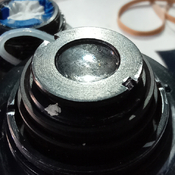Why would you want to remove the coatings? It'll only make matters worse.
A subject U discussed with a photographer on Saturday, he has a Kodak Ekttar 127mm and the coating is damaged. It's damage in one area, with B&W images it makes no visible difference, but with C41 negatives he says there's a patchy colour balance change.
I have some old ( non-camera ) eyepieces, all of which were badly 'cleaned' over the years leaving deep looking lines on the coating ( not glass scratches ) which I'd like to clean off back to the glass.
If there a safe way of removing these coatings ?
They are from the mid 1980's and 'bloomed' blue ( if that helps ? )
Many thanks,
John S
By the mid 1980s most lenses had excellent hard coatings, the big change was multiple coatings (as in more than one layer/type) in the early to mid mid 1950s to ensure good colour balance, Early Carl Zeiss coating introduced in 1938 was excellent and hard wearing but gave a slightly cold blueness. I have/had a 1953/4 CZJ T coated 150mm f4.5 Tessar, and it is a noticeable blue tinge.. Lenses like the CZJ 50mm Pancolar, the Colour Skopar, etc, had cotings better optimised for colour work.
Kodak's Blooming was probably amongst the softest coating. I have had quite a few Kodak 203mm f7.7 Ektar lenses, most UK made, and you can see changes in the coatings.
The poorest are the early ones in Kodak Epsilon shutters, these are in catalogues as "Bloomed", later one's in Prontor #0 SVS shutters have excellent coatings, as do the last in #0 Synchro Compurs which have better colour corrected coatings. I only have one Eastman Kodak version, which is one of the last mage, and in a Graphic Syncro Compur #1.
If you'd like to see the problem ....
That element would need removing a re-polishing by someone experienced.
Ian








